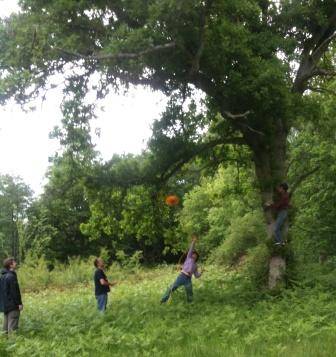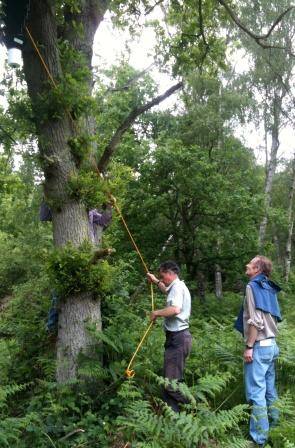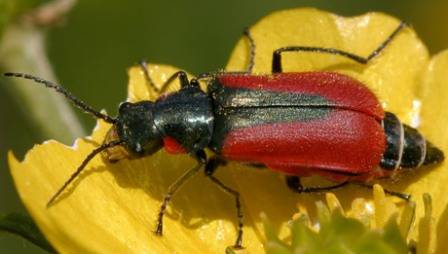Hello beetlers,
Now that spring has passed and summer is truly upon us, the field season begins. This is when entomologists get very excited about the prospect of going out in to the countryside (well, just ‘out’ really) with their sweep nets and collecting gear in pursuit of insects! Here in the coleoptera section, we are no exception, and when Max suggested a fieldwork day to Bookham Common, we literally jumped at the chance!
Here we are, literally jumping!

From left to right Alex Sadek, Max Barclay, Malcolm Kerley, Libby Livermore, Beulah Garner, Laurence Livermore. Image courtesy of Libby livermore.
So what does field work mean to us? Well, we don’t just go out and collect insects - we go out looking for insects. We may have an idea of what we might expect to find, especially at any given time of the year, habitat or host plant. And when we find them, we record them. This information can then be fed in to local as well as national databases which record distribution of species across the UK. This is vital information to inform those that are involved in habitat and species protection / conservation, as well as climatologists (insects are very good indicators of climate change) and politicians!
Here is the link to the National Biodiversity Network http://www.nbn.org.uk/
Thereby much of what we find, we record and set free. However, should we be looking for a specific species, especially if it is not commonly found in the habitat in which we are collecting, we will retain the specimen for confirmation of identification and to provide what we call a voucher specimen. A ‘voucher’ provides tangible proof that the species exists and was found in a certain location. This voucher is then deposited in the Museum collection to act as a permanent record for the future.
Here is the striking wasp mimic Clytus arietis (Cerambycidae), which we did set free! Image courtesy of David Oram.
So off we set to Bookham Common. Why Bookham Common, well it is a very important area for wildlife and has species records dating back over fifty years meaning it is one of the best and most comprehensively recorded sights in Britain. The various habitats include wet grassland, low lying meadows, scrub, ponds and (ancient) woodland. So here, not only can the past inform the future by for example, the analysis of species distribution trends or species ecology, such as time of insect emergence correlated with weather, but we can continue to build on this data by regular recording of what wildlife is present.
The commons are managed by the National Trust and principally recorded by members of the London Natural History Society; follow the link to find out more about the LNHS.
http://www.lnhs.org.uk/
Here is Roger Booth demonstrating his 'pootering' technique to some fascinated passers-by! For those of you that don't know, he is holding a 'beating tray'. This is placed underneath a selected tree, the tree is beaten with a big stick, and hopefully some interesting insects fall out!
The coleoptera section has got some shiny new collecting equipment that we couldn’t wait to try out - seriously!
These new traps are called Lindgren funnel traps and are a series of black funnels connected together with a collecting trap at the bottom and a bait trap in the centre.
Lingren funnel trap in the tree canopy. Image courtesy of David Oram. Here is Malcolm Kerley (right) demonstrating the addictive properties of the bait trap!
The idea is that insects are attracted to the pheromone bait and fly into the funnels – the funnels are so shaped that the insects cannot fly out, but rather end up in the bottom of the trap which contains a collecting fluid such as ethanol with a drop of washing-up liquid to break the surface tension. These traps are commonly used in the USA to collect forest pests such as bark beetles (Scolytidae). The traps are hoisted into the canopy of the tree and secured by a long rope.
Imagine the logistics of first selecting a suitable tree, and then working out just how to get the trap into the canopy of said tree. This part of the fieldwork took some time, and involved much throwing of rope: 
Throwing the rope!
Standing around thinking about throwing the rope!

Letting go of the end of the rope so that it landed completely over the other side of said tree and not actually in the tree…
And so it went on until eventually there was success!

Question: how many entomologists does it take to throw a rope?
From left to right Malcolm Kerley, Alex Sadek, Max Barclay, Max Barclay (stuck in a tree?) Roger Booth, David Oram.
But the major event of the day was the finding of the Scarlett Malachite Beetle, Malachius aeneus (Malachiidae - Soft-winged flower beetles).
© Chris Gibson
This beetle, whose range has declined to such an extent that it is listed as 'rare' on the UK’s Biodiversity Action Plan, http://jncc.defra.gov.uk/default.aspx?page=5155 is currently only known from eight sites throughout the UK.
For more information on this beautiful beetle, and especially if you would like to attempt to see it in the wild, go to Buglife, who are currently running a Scarlet Malachite Beetle Survey to help monitor this beetles’ populations.
http://www.buglife.org.uk/
OPAL (Open Air Laboratories), who have just launched their fantastic Bug Hunt Survey, will also help you to get outside and go collecting – more details here:
http://www.opalexplorenature.org/
Our Plymouth University intern Lucia Chmurova was sweeping a verge in the early afternoon consisting of mixed vegetation of rough grasses, buttercups, cow parsley and dock, when this beetle was caught in her net. This was truly an amazing find as this beetle hasn’t been recorded in Surrey for more than 50 years (Denton, 2005) and is a first record for Bookham! So well done Lucia, perhaps we are all ‘scarlet’ with envy, rather than green, at this find!
Here is Lucia investigating the undergrowth!
Lucia’s note will be published in the next edition of the Coleopterist.
http://www.coleopterist.org.uk/
For some excellent cinematic photos of the day follow Libby Livermore’s (our official capturer of entomologists in action) link here:
http://www.flickr.com/photos/evilibby/sets/72157626652914393/with/5748748470/



